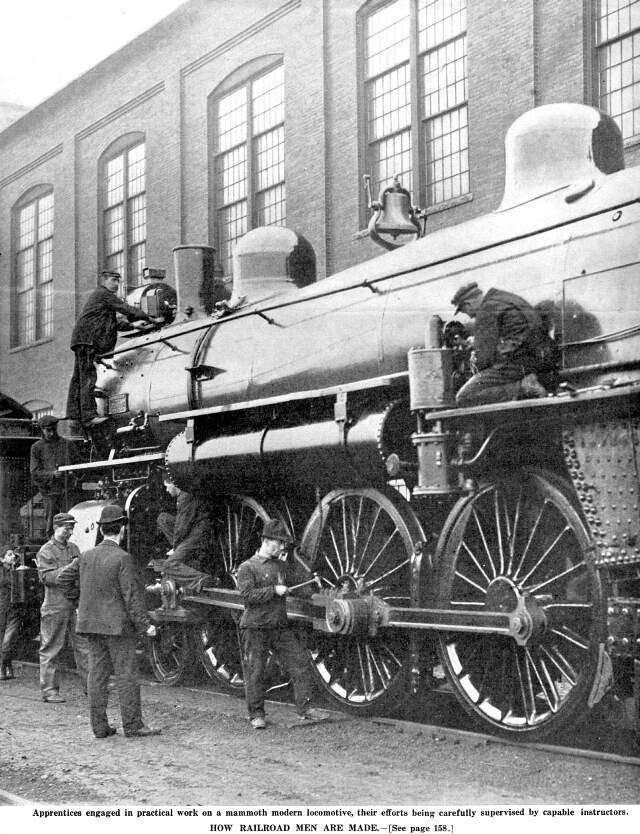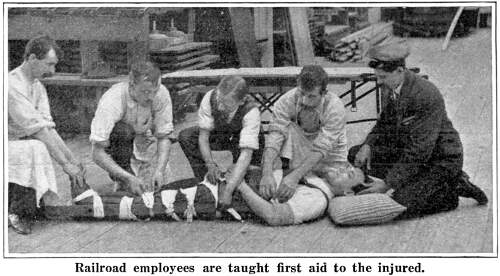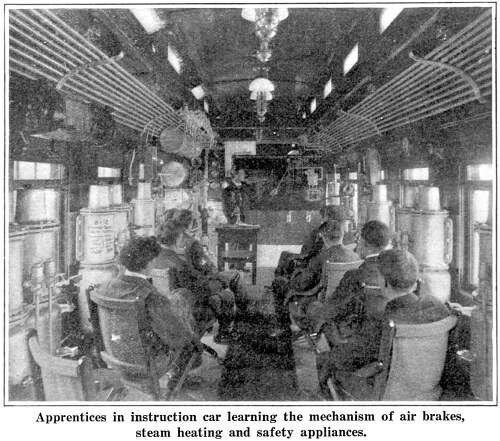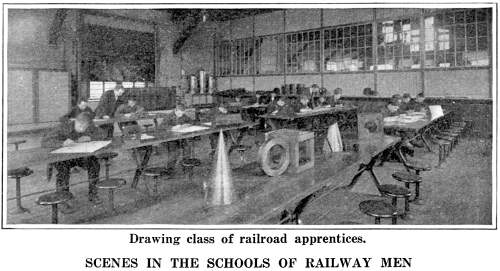|
Scientific American—February
17, 1912
How Railroad Men are Made
Training the Men Who Run Big Railways
By P. Harvey Middleton
 IN 1912, with
our railroads forming a gigantic network of 240,000 miles, representing
an investment of twenty-two billions of dollars, earning for their
owners over a billion dollars every year, carrying a billion passengers
and two billions of tons of freight in the twelve months, necessitating
the employment of 1,700,000 persons more than twelve times the
combined strength of our army and navy the requirements of railroad
men of all grades, from track walker up to president are exacting
in the extreme. Professional training, a clear head, steady nerves,
and strong muscles are some of the requisites, but training is
the most important of all. The old style of railroad man who could
not read a blue print or make a freehand sketch, would be as useless
a cog in the mighty wheels of our transportation system as the
superb courage of the Mahdi's troops was when opposed to discipline
and breechloaders. IN 1912, with
our railroads forming a gigantic network of 240,000 miles, representing
an investment of twenty-two billions of dollars, earning for their
owners over a billion dollars every year, carrying a billion passengers
and two billions of tons of freight in the twelve months, necessitating
the employment of 1,700,000 persons more than twelve times the
combined strength of our army and navy the requirements of railroad
men of all grades, from track walker up to president are exacting
in the extreme. Professional training, a clear head, steady nerves,
and strong muscles are some of the requisites, but training is
the most important of all. The old style of railroad man who could
not read a blue print or make a freehand sketch, would be as useless
a cog in the mighty wheels of our transportation system as the
superb courage of the Mahdi's troops was when opposed to discipline
and breechloaders.
From this it may be seen that the education of apprentices
on a twentieth century railroad is the most important problem
of the company. Just as the United States Government has a West
Point and an Annapolis for the training of its future admirals
and generals, so our great railroad systems all have training
schools for the production of educated workmen, foremen, and superintendents
academies where the raw recruit is initiated into all the mysteries
of railroading, from the making of drawings to the assembling
of locomotives, which later grow before his eyes from nondescript
heaps of metal and pass out into active service. He helps to build
these leviathans of the rails, and to repair them when they come
limping back, strained from overwork or torn to pieces by collision.
Let us follow the various stages in the career of one of these
novices during his four years apprenticeship in Railroadville.
We will call him William Smith. He has applied to the general
manager of the road, John Brown, for admission as an apprentice.
Brown sees that he is an intelligent-looking chap and cross-examines
him as to his mental and moral fitness.
 "We have
two grades of apprentices," says Brown; "special and
regular—all of whom stay here three years. The boy with a
public school education is drafted into the regular class, to
train for the rank and file. The special must be a college graduate,
and qualify for the higher positions. Take my advice, Smith, graduate
from your college, and we will admit you as a special. But remember
this; it is four years of solid hard work and precious little
play. Ten hours a day, 304 days a year, you will have to work
in the shops. You will work under the superintendent of the motive
power department, and do whatever he orders—crawl into the
warm fireboxes of locomotives, sweat in the glare of a white-hot
furnace, wield a hammer in the ear-splitting din of the boiler-room,
or paint the interior of a parlor car. It's all in the day's work.
The reward? Well, it depends on your ability. The salaries of
railroad men range all the way from $500 to $50,000 a year. When,
you have had your training, it's up to you." "We have
two grades of apprentices," says Brown; "special and
regular—all of whom stay here three years. The boy with a
public school education is drafted into the regular class, to
train for the rank and file. The special must be a college graduate,
and qualify for the higher positions. Take my advice, Smith, graduate
from your college, and we will admit you as a special. But remember
this; it is four years of solid hard work and precious little
play. Ten hours a day, 304 days a year, you will have to work
in the shops. You will work under the superintendent of the motive
power department, and do whatever he orders—crawl into the
warm fireboxes of locomotives, sweat in the glare of a white-hot
furnace, wield a hammer in the ear-splitting din of the boiler-room,
or paint the interior of a parlor car. It's all in the day's work.
The reward? Well, it depends on your ability. The salaries of
railroad men range all the way from $500 to $50,000 a year. When,
you have had your training, it's up to you."
"I'll come when I graduate next year," replies Smith,
quickly.
And a year later Smith gets out at Railroadville with his grip.
That preliminary talk with Manager Brown has prepared him somewhat
for the simple strenuous life. He hires a small room in a boarding
house kept by the widow of a railroad man. For the first day or
so the meals and the drab atmosphere of the place induce a severe
attack of homesickness. But the antidote of hard work soon replaces
that with an appetite which the habitué of
the foremost restaurants might well envy.
On his first week in the shop he is sent to the erecting room,
where he studies the different parts of a locomotive and is taught
the work they perform. When he has proved that he has thoroughly
absorbed this knowledge, an old hand takes him inside a defective
boiler, and under the experienced man's direction he repairs it.
After six months of this sort of work his hands have become so
rough and calloused, and his, general appearance so dusty and
grimy, that it is hardly probable that the girls back home would
recognize their dancing partner in this hardy son of toil; and
his fellow apprentices in the special class-one a senator's son,
another the son of the president of the road-are similarly disguised.
 Smith now
goes to the machine shop for six months, in order to learn how
to operate the great lathes which are used to shape the steel-powerful
yet delicate pieces of mechanism which cut the steel to the required
form as easily as a planing mill shapes pine boards. Then come
three months in the vise shop, where instruction is given in the
fitting and polishing of driving rods and the finishing and adjusting
of valves. This is followed by two months in the airbrake shop,
and two months more in the blacksmith shop, where he is taught
the working of the big steam hammers, the heavy sledges, and the
giant forges. Smith now
goes to the machine shop for six months, in order to learn how
to operate the great lathes which are used to shape the steel-powerful
yet delicate pieces of mechanism which cut the steel to the required
form as easily as a planing mill shapes pine boards. Then come
three months in the vise shop, where instruction is given in the
fitting and polishing of driving rods and the finishing and adjusting
of valves. This is followed by two months in the airbrake shop,
and two months more in the blacksmith shop, where he is taught
the working of the big steam hammers, the heavy sledges, and the
giant forges.
A course of two months in the foundries, casting and molding,
is followed by two months in the boiler shop and this latter is
the most trying period of his apprenticeship; for he is called
upon to work amid the din of hundreds of hammers smashing against
the iron ribs of great boilers, a deafening and distracting turmoil
which results in some sleepless nights for Smith until he becomes
accustomed to it—as he soon does.
The next class room in this strenuous schooling is the car
department, where four months are spent in the freight shop and
two in the passenger car shops, where Smith thoroughly masters
the building of everything on rails, from a hand car to a Pullman.
Then come four months in the roundhouse—the garage of the
railroad where locomotives in active service come in between the
runs to be inspected and cleaned. Then Smith's apparently endless
mechanical training is brought to a close by three months' duty
as fireman on the road.
 Now for the
final year, to be spent in the cleaner but none the less strenuous
business departments. Shedding his jumper and overalls, Smith
enters the office of the shop clerk, and for two months he studies
the ordering and distributing of supplies. Graduating from this,
he places himself at the disposal of the motive power clerk for
another two months, learning the elaborate system by which locomotives
are built and dispatched to the various important points. Now for the
final year, to be spent in the cleaner but none the less strenuous
business departments. Shedding his jumper and overalls, Smith
enters the office of the shop clerk, and for two months he studies
the ordering and distributing of supplies. Graduating from this,
he places himself at the disposal of the motive power clerk for
another two months, learning the elaborate system by which locomotives
are built and dispatched to the various important points.
Five months must now be spent in the testing room, where he
watches the railroad chemist testing the steel alloy used in the
construction of axles, tires, boiler plates, and frame plates.
His apprenticeship winds up with three months in the drawing room,
and Smith becomes the proud owner of an honestly won diploma,
which enables him to obtain an executive position from which he
can climb to the highest salary in the gift of the road. He is
a railroad man in the truest sense of the word, of the stuff that
presidents are made of.
Where are these railroad academies? Well, the Pennsylvania
Railroad has one at Altoona, Pa., the Santa Fé system has
twenty-four schools, the New York Central has schools in nine
of its shops in the United States and one in Canada. The Grand
Trunk, Erie, D. L. &. W., D. & H., Jersey Central, and
Chicago Great Western all have similar schools.
The Union Pacific has a very extensive educational system.
In addition to the correspondence work, a station training school
has been established at Omaha to prepare men to enter the station
service of the company. This station school is equipped similarly
in all respects to a regular station of medium size, and is under
the direction of one of the company's experienced agents. All
men entering station service on the system are required to pass
through this station training school before being employed.
In the regular classes applicants are required to state their
previous education and experience; whether they are subscribers
to any technical magazine; whether enrolled with any correspondence
school; in what line of work they wish to advance; and to what
position (in reason) they are ambitious to attain.
The Canadian Pacific, at its Angus works in Montreal, has also
recently inaugurated a new system of training employees; and in
order to encourage deserving apprentices, the company donates
each year a scholarship to the best ten apprentices, consisting
of complete courses in mechanical or electrical engineering. The
railroad also awards two scholarships, tenable for four years
at McGill University, Montreal.
The young clerks in the general and other offices at Montreal
have equal opportunities with the apprentices in the shops for
equipping themselves for their life work. Schools of telegraphy
and shorthand have been in operation for some time, and the advantages
they offer are being eagerly seized by a number of ambitious youths.
There are two terms each year, and the classes meet three evenings
a week, when the students of telegraphy are instructed in the
mysteries of the key, taught how to dispatch trains, etc.
Stories Page | Contents Page
|







